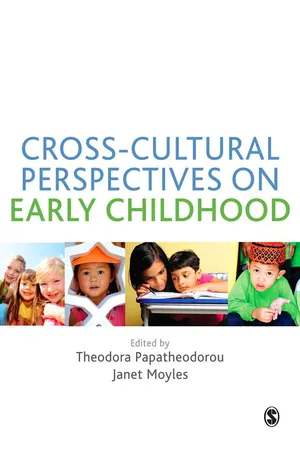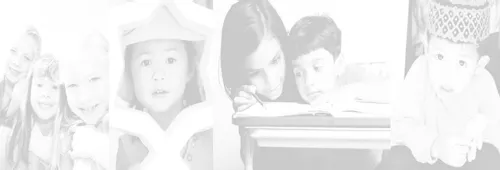![]()
Part 1
Children’s Learning Cultures
Introduction
Janet Moyles and Theodora Papatheodorou
The Education for All: Strong Foundations Report states: ‘Early childhood sets the foundations for life ... [it] is a highly sensitive period marked by rapid transformations in physical, cognitive, social and emotional development’ (UNESCO, 2006: 7). It is also a period in which children – already undergoing massive changes physiologically and cognitively – acquire understanding of different cultures. From the culture of the home and community, children in many parts of the world move into a culture of early childhood education and care (ECEC) which requires significant new learning if the child is to adapt to the new context and all its underlying complexities and expectations.
The culture of settings and schools requires quite different understandings from both children and their parents/carers; they have to be acculturated into such aspects as routines, expectations of the people involved, what is permitted and what is not, how one is supposed to behave in this new context and whether the children can play!
Children’s play is a universal phenomenon in development and learning that is culturally grounded and is the basis of many early childhood education settings and curricula. As Wood says:
By emphasizing the socially and culturally situated nature of learning, children can be understood as active participants in cultural communities ... Participation also provokes situated agency – children actively engage in the social construction of their own identities and subjectivities. (2010: 11)
Needless to say, observing and interpreting children’s learning and play differs from culture to culture because of individual norms within cultures. For example, the individualistic nature of western cultures means children are expected to achieve as individuals whereas the more collective societies of, for example, the Far East and Africa advocate more collective outcomes.
We all have a culturally shaped mindset. It is clear that how we interpret children’s play, learning and development differs from culture to culture (Brooker and Edwards, 2010). Solitary play, for example, was once thought to be the province of only very young children but the culture of today’s media-based societies means that this is historically and culturally outmoded because all ages of children now seem to spend much solitary time on computers and gadgets (Marsh, 2004).
That said, it has also long been acknowledged that children’s learning is multi-dimensional: children learn through every aspect of their senses and this enables them to make meaning of the experiences they encounter in an ongoing way. Heuristic play is just one such form: ‘heuristic’ means helping to find out or discover; proceeding by trial and error, which is described by Esgate and Groome as ‘if you can think of it, it must be important’ (2004: 12). Such importance is afforded particularly in the first chapter constituting this section, written by Sue Gascoyne about her experiences of developing a sensory play continuum, used in the UK but with implications for global ECEC practice. Sue begins with the concept of treasure baskets and heuristic play as the basic sensory stimulation for babies and toddlers but then develops the argument for use with older children to encourage creativity, problem solving and trial and error learning. She explores the research and practitioner training she has undertaken to verify her assertions regarding the need for high quality sensory experiences for children.
In Chapter 2, these experiences are broadened to include outdoor sensory experiences for children through a chapter about Forest School and the importance of a culture of outdoor play provision in several European countries, written by Sara Knight. This experience provides yet another different cultural context for learning, with further norms, rules and considerations, for example to do with safety and risk but also learning about the natural environment and sustainability. The Forest School context also provides extended and different opportunities for children to play and problem-solve. Under Article 31 of the UN Conventions on the Rights of the Child, (UNCRC) play – and in this case outdoor play – is the right of every child and something, one could argue, that we ignore at our peril given the current challenges in the western world with regard to children’s health and well-being (Albon, 2011), as well as their capacity as capable learners.
This takes us neatly to Chapter 3, in which Maulfry Worthington writes absorbingly about her research into graphicacy in early childhood, acknowledging the centrality of the child’s perspective that enables each child to explore a complex interplay of meanings in ways that are powerful and personally relevant. Graphicacy, in this instance, is described as a concept similar to ‘mark making’ in early childhood education where these ‘marks’ incorporate children’s multi-literacies, crossing all curricular barriers. They are the ‘graphics’ which children produce and which convey great meaning. Maulfry stresses that this perspective rests on a poststructural view of the child as a co-constructor of knowledge, culture and identity and recognises all children as capable and intelligent with the support of informed, committed and reflective practitioners (Moyles, 2010). This chapter shows clearly how the culture of formalised learning differs greatly from the culture of child-oriented and initiated learning, the ‘situated agency’ outlined by Wood above. Many international countries are now recognising the agency of the child since the UNCRC, and Maulfry’s findings are applicable internationally.
That children are agents in their own learning and are instrumental in developing their own cultures of learning is evidenced in the final chapter of this section by Mallika Kanyal and Linda Cooper. Fascinating research carried out by these two writers delved into 5- and 6-year-olds’ perceptions of their socially and culturally different school experiences and children’s perspectives. Being carried out in India and England, the study offers a view of differences and similarities in practices and children’s perceptions of their environment. The chapter also explores a range of methods for gathering child-focused data which has worked across cultures and shows links with the previous chapter.
In the next section, we move the focus to the cultures of pedagogy that support children’s play, learning and development.
References
Albon, D. (2011) Promoting Children’s Health and Well-being in Primary Schools. In J. Moyles, J. Georgeson and J. Payler (eds) Beginning Teaching Beginning Learning (4th edn). Maidenhead: Open University Press.
Brooker, L. and Edwards, S. (2010) Engaging Play. Maidenhead: Open University Press.
Esgate, A. and Groome, D. (2004) An Introduction to Applied Cognitive Psychology. New York: Psychology Press.
Marsh, J. (ed.) (2004) Popular Culture, Media and Digital Literacies in Early Childhood. London: Routledge.
Moyles, J. (2010) Thinking about Play: Developing a Reflective Approach. Maidenhead: Open University Press.
UNESCO (2006) Education for All Global Monitoring Report: Strong Foundations. Available online at: http://unesdoc.unesco.org/images/0014/001477/147794e.pdf (accessed 14 March 2011).
Wood, E. (2010) Reconceptualizing the Play–Pedagogy Relationship: From Control to Complexity. In L. Brooker and S. Edwards (eds) Engaging Play. Maidenhead: Open University Press.
![]()
1
Seeing the wood for the trees: adults’ roles in supporting sensory play
Sue Gascoyne
Overview
Over the last century, Steiner, Dewey, Montessori and Malauzzi have all made the case for the numerous benefits of sensory play. With evidence that children’s access to sensory play is in decline, the treasure basket can potentially offer a tool for increasing sensory stimulation, especially when the three stages of play set out in the Sensory Play Continuum are followed. Treasure baskets are used for simple exploration, problem solving and domestic role play (see Goldschmied and Jackson, 2004); older children use them in pretend and goal-oriented symbolic play, where the objects became something new, reflecting and portraying children’s ideas and thoughts; when combined with other resources, the potential for creativity and problem solving significantly increases. Adults have a crucial, yet subtle role in maximising quality sensory play opportunities from play with a treasure basket across all three stages of the Sensory Play Continuum. This chapter explores whether treasure baskets can help compensate for children’s limited access to multi-sensory experiences and, if so, what role adults have.
Picture a children’s play area on a wet and cold day with a group of toddlers excitedly jumping in muddy puddles. Their delight is apparent but what remains a mystery is what each individual child is most enjoying or gaining from this sensory-rich experience – be it the satisfyingly noisy splash, the striking cold feel of the water gushing into their wellies, the swirly patterns as their feet stir the mud into the puddle, feeling ‘at one’ with nature, exploring and discovering ‘cause and effect’, the liberating feeling of space, time and freedom or a myriad of other unique sensations and experiences. The author observed this group for approximately 20 minutes: the puddle sustained their interest while some nearby play equipment remained conspicuously empty. The children were ‘enjoying some fresh air’ with enlightened childminders but what of their parents’ reactions to their mud-encrusted clothes later that day? Some may have reminisced about similar experiences from their childhood, others may have reflected upon the amazing learning potential of a puddle and still others may have simply sighed at the thought of all that washing! This snapshot succinctly illustrates two key strands to this chapter: (1) the importance and appeal of sensory-rich play for children and (2) the role of adults in supporting and encouraging such experiences.
The benefits of sensory stimulation
Ask an adult about their typical childhood play memories and chances are they might reflect upon days spent exploring, climbing trees, building dens, lighting fires and making mud pies and rose petal perfume! If you can relate to this happily, you are not alone: these were just some of the vivid childhood play memories that 146 parents and practitioners retold as part of the national Sensory Play Research project (Papatheodorou, 2010).
Those lucky enough to share such memories will probably understand why children get so much from sensory-rich play and why it is important. Watch children’s concentration, focus, determination, problem solving and social skills as they play with natural materials. Not only is it hugely satisfying for children but it’s often free, requiring little or no preparation. The value of sensory experiences (both inside and outdoors) and benefits for children’s learning have been highlighted by a raft o...




